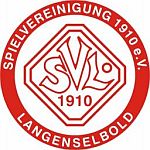SpVgg 1910 Langenselbold
The SpVgg 1910 Langenselbold is a football club in the East Hessian town of Langenselbold . In 1934 and 1940, the team rose twice to the Gauliga Hessen , the top division at the time, and in the 1980s they aimed for promotion to the top Hessian amateur division, which they never reached. The SpVgg Langenselbold has played in the leagues of the Hanau soccer district since the 1990s.
history
As the first football club in Langenselbold, the sports club was founded in 1910 in the restaurant "Zum Felsenkeller". In the same year, a second club was formed with FC Viktoria . Immediately after the First World War, on May 19, 1919, both merged to form the 1910 Spielvereinigung . The club area "Auf der Sieb" served as a sports field.
In 1925, the SpVgg rose to the second division in 1910 and encountered well-known opponents such as Viktoria 94 and Sport 1860 Hanau , who are now united in TSV 1860 Hanau . At the beginning of the 1930s the most successful phase in the history of the Red-Whites began. Led by the offensive middle runner Hermann Wittman, the young talents of the club developed into a strong team that soon made it into the top division. The fact that a group around the former chairman Konrad Krieg split off in 1930 and founded the SV 1930 Langenselbold , which still exists today , did not detract from the upward trend in the "tens". In the round of 1933/34, the first after the introduction of the Gauligen as the highest level, the club from the then 8,000-inhabitant town in the Kinzig Valley became district champion, and after two victories over Alemannia Niederbruch in the promotion round of the Hessen-Süd group rose to the Gauliga Hessen on. Despite a few surprise successes such as a 3-2 home win over CSC 03 Kassel or a 2-2 win against the neighbor and later Gaumeister Hanau 93 , the "Zehner" could not hold the class and immediately relegated as the penultimate of the 1934/35 season . The immediately following crash into the A-class could be absorbed again and reported back in the first year of the war in 1939/40, reinforced by various guest players in the regional top. But the second Gauliga season was also the last season of the red-whites in the first class, because the high-altitude flight lasted only a short time. The SpVgg 1910 ended the round 1940/41 with a bleak record of 6:52 goals and ten defeats. In 1942 the game was stopped due to the war.
The small town in East Hesse grew rapidly after the end of the war due to refugees, as a result of which the sports clubs experienced a strong increase in membership. Supported by the local manufacturer Julius Vogel, the SpVgg succeeded in restoring the sports field and rebuilding a competitive team in 1910 . Reinforced by former Frankfurt Eintracht players such as "Bubi" Kraus , Emil Arheilger and Horst Schmitt and occasionally trained by the later Oberliga trainer Paul Oßwald , the sports association reached the second amateur league in Hesse in the post-war period. With that, however, the temporary high point was already exceeded, because gradually the "tens" slipped down in the league hierarchy until the low point was reached with the descent to the B-Class in 1968.
It wasn't until a decade later, at the beginning of the 1980s, that the red-whites began to move towards higher leagues again. Under the chairmanship of Dieter Fuchs, the team trained by Wolfgang Knapp and strengthened by various foreign footballers first made it into the district class in 1982, and just two years later the SpVgg rose to the Hessian state league in 1910 . Up to 1000 spectators came to the home games and hoped for another athletic promotion of the "tens" to the amateur upper house. In the 1985/86 season, the team trained by the former OFC goalkeeper Karlheinz Volz was considered a "secret favorite" for promotion to the Hessen League, but after a disappointing eighth place, neither Volz nor his successor Alfred Haas made it - despite considerable financial efforts by the club - lead the team to promotion.
The investment in advancement to the top amateur class, which was ultimately never achieved, took revenge in the 1990s. After the club's treasury was exhausted due to the need to build a new clubhouse, the simultaneous relegation to the A-class even threatened bankruptcy at times. The economic bankruptcy could finally be averted, since then the SpVgg has been sporting in the divisions of the Hanau soccer district in 1910 . From 2012/13 up to and including 2014/2015 the 1st team played under the direction of Patrick Falk in the district Oberliga Hanau. The 2nd team achieved promotion to the A-class in the 2015/2016 season.
literature
- Hardy Greens : Legendary football clubs. Hesse. Between FC Alsbach, Eintracht Frankfurt and Tuspo Ziegenhain. AGON Sportverlag, Kassel 2005, ISBN 3-89784-244-0 , p. 278.
